Much has been made in the media recently about the new configuration of Pennsylvania Street between St. Clair and Washington. Some of it has been informative, and some hasn’t. Â It’s a good idea at this time to take a step back and reflect on the main goal of the initiative: To increase safety for bicyclists.
Partially because of the backlash, I decided to wait until they were closer to being finished to write a post on these lanes. There still may be a little bit of work left to do, but they are close enough now that the improvement is getting more obvious:

Here are some pdfs that help describe the new configuration, courtesy of IndyCog and Sustain Indy:
In addition, IndyCog is hosting an awareness ride on Friday, December 4th at 8 am. The ride starts at the Indianapolis Public Library and continues down Penn towards Washington Street.
About the only downside for this new bike lane is that it will make most of the other ones in the city look inferior. Also, the lanes start at St. Clair Street, which does not have a connecting cycle path. These are good problems to have.
This helping to lead the path forward for cycling in Indianapolis. I can’t wait to see the next initiative on the near east side.
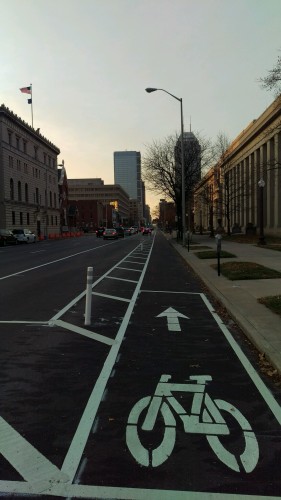
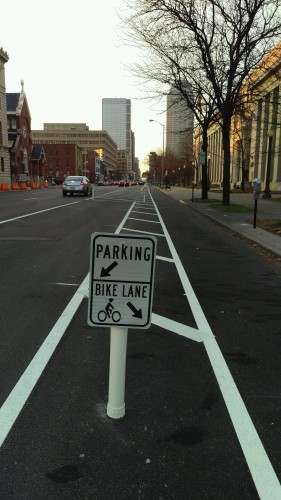
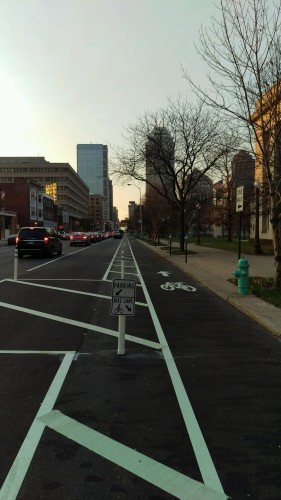
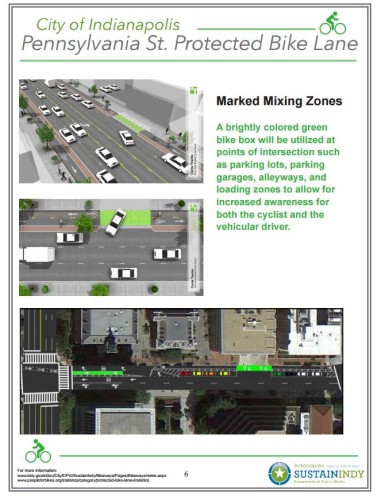
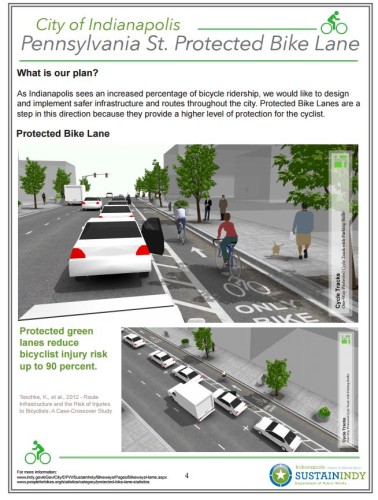
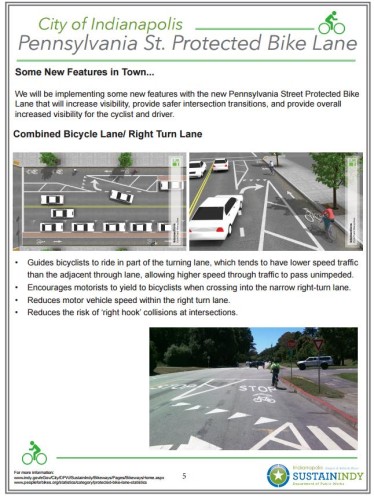
This is fantastic! I was able to take a brief look at the Penn Street bike lanes while I was in town but was unable to try them out (bummer). The right-turn merging portions aren’t ideal, but it’s not horrible; certainly better than, say, sharrows on Shelby (never again).
What I would love to see is this space enhanced in the summer. Many cities place flower boxes in the protected zone; relatively inexpensive additions to beautify the space. All in all, this is a big step forward for the city, I’m pleased.
Screw this riding right next to the curb, where the pavement falls apart the fastest, and where all the dirt and debris winds up. I will just ride right down the middle of the traffic lane like always. There is nowhere to pass slower cyclists either, since you’re boxed in. Tired of being subjected to facilities designed to keep 5 year olds safe.
Have you actually used it? If so, you would know there is about 8 feet from the curb to the bollards (plus another 18 inches to the cars). More than enough to allow cyclists to pass each other. I ride it northbound and pass southbound cyclists with plenty of room.
Kevin, I think there’s some logic in the location.
Penn (sort of) connects to The Cultural Trail at St. Clair via the American Legion Mall; St. Clair is where the Trail officially crosses Meridian. So that creates a protected bike path from the northeast edge of the IUHealth/IUPUI campus into the east side of downtown. (The White River and Washington Street part of the Cultural Trail already connect the south end of campus.)
I think this lane is truly great to see and I look forward to using it sometime soon. My only feedback about it is on the use of the plastic pylons for the protected buffer in between the parked cars and the lane itself. I know that the cars are generally supposed to give the physical barrier between people on bikes and the moving cars in the main vehicle lanes and I agree that they will. However, they’ll be very fragile in our northern snowy climate and I can foresee them being destroyed one by one from the snow plows either directly hitting them when there aren’t parked cars, or by the snow piles pushing them over. This type of thing has happened in Chicago and it really won’t be any different here.
Also, it’ll be interesting to see what the snow plow drivers do with these lanes. Will they push the snow into the new parking lane or into the bike lane itself? Who will be clearing the bike lane and how, as a plow can’t fit in this lane.
Knowing Indianapolis, only the heat from the Sun will be clearing the bike lanes.
Is there a reason why they didn’t make the lanes ACTUALLY protected, I mean with a curb, bumps or a median? This is really nice but it’s only technically protected, if someone wanted to, like the old man that was complaining about the lanes in the paper, they could just run over the little flimsy markers and into the bike lane.
just curious.
I’m sure cost is the number one factor.
They are ACTUALLY protected. There have been at least a couple of cars between traffic and the bike lane. There are especially a lot of parked cars at the most dangerous time for traffic – morning rush hour. Over half the spots have cars parked (perhaps aside from block near the Central Library.
Additionally, bikes are protected from dooring by the 2 foot buffer zone which is, in my opinion, the more pertinent danger (vs a car veering between to cars and all the way to the protected bike lane).
The only backlash against these lanes have been from the Luddites (especially one notable member of the media who has recently passed). This configuration has been in use for years in much more forward-thinking communities than Indy.
Hopefully this is just a taste of what’s to come.
That old man that wrote the article about bike lanes passed away??
No, she’s referring to the late Amos Brown. Overall, he’s missed in the Indy Media scene, but he was generally antagonistic towards bicycle infrastructure initiatives. Nobody’s perfect.
If bike lanes aren’t protected they aren’t worth having. The bike lanes we have all around the city actually make cycling more rather than less dangerous. Serious bicycle commuters avoid them.
You can say it all you want, but it just isn’t true, Paul. Indy wouldn’t be where it is in terms of bike culture if ten years ago they had said, “Well, we can’t make protected bike lanes, so let’s just make none at all. It is incremental – just look at the evolution of the Michigan/New York lanes.
And in any case, each day I see a number of bike commuters in traffic adjacent bike lanes. I’m not talking about fixie messenger psychopaths, I’m talking about people with rain slickers and panniers.
And this new protected bike lane isn’t about bike commuters anyway. This lane is about everyone else. My 6 years olds will ride in this lane. My 80 year old neighbor could ride on this with his trike. Men and women will ride in this lane.
Not a fan in the least. The idea that bikes will be hidden from the view of the drivers in the area by other parked cars/VANS/SUVs is a terrible idea and I believe will lead to many an accident. Sure, they are trying to tell cars to merge through that parking lane, but tell me they won’t miss a commuter coming out from behind a van and cause a death. Parking, imho, should always be next to the curb and the bike lane next to traffic for visibility reasons. Placing some planters between traffic and the lane is fine, but not a row of big ass SUVs. 🙁
From what I saw, there aren’t any parallel parking spots close to the intersections. Probably for this reason.
If the bike lane is adjacent to traffic, what does it take for a cyclist to die? A single glance at a cell phone. If the bike lane is a parking protected lane, what does it take for a cyclist to die? Swerving to the right 12 ft and having enough velocity to plow through a parked car or enough luck to squeeze between two parked cars. I’ll take the parking protected lane any day of the week.
Also, everything I’ve ever read on bike lanes ever says that protected lanes are safer than traffic adjacent lanes. About the only people preaching anything else are the 20 remaining vehicular cyclists left in the country.
I’ll also add, you are welcome to take the lane if you want to remain visible, but these protected lanes are not about you. My 6 year olds will be able to use these lanes. I would never allow them to ride on a traffic adjacent lane as long as they are under my roof.
Using parking as a buffer has been proven successful in other cities.
Couple of you missed my point. I don’t mind the protected lane by any means, but I don’t think parking is the way to protect the lane. Too many and too big of a distraction between the rider and moving vehicles. Bob says its been proven effective in other cities. The question, more effective than low planters? I doubt it. Better than nothing.
That would require the removal of parking though and you know people would throw a massive hissy fit if that happened. This restriping actually added 6 parking spaces, oddly enough.
Just rode this today and I’ll admit the lane does feel quite safe when there are parked cars present. There are a few shortcomings:
1) When there aren’t parked cars, obviously there are some safety problems.
2) The painted lines/poles are terrible looking. Knowing Indy’s disdain for spending any money on this type of thing, I can look past it.
3) Why end it at Washington, when there is a bikeshare station in front of Banker’s Life?
And the biggest oversight:
4) Where’s the return route??
1. Ya, that may be true.
2. Ok. I think they’re fine.
3. The Cultural Trail is on Washington. That’s not to say that it can’t go further.
4. I bet the return route will be on Illinois when the Red Line is installed.
I guess I should have clarified my gripe with #2, and preface it by saying I really do think this is a great step forward for Indy. BUT –
When Ralston laid out Indy’s street grid, that was 500-year infrastructure.
When Kessler laid out our parks and boulevards, that was 200-year infrastructure.
When 65/70 was built, that was 100-year infrastructure (hopefully less).
This paint and pole stuff looks like 5-year infrastructure, more experiment than anything else.
You can’t change a culture of car dominance with a cheap-looking experiment.
this project was done because of the resurfacing that happened on Penn. That is why the project limits are where they are. the posts allow us to tweak the design before hopefully installing more permanent separation. there is a two-way, separated bike lane that is being planned as part of the Red Line. Penn was pretty low-hanging fruit for the first lane like this. There really are not any cars turning across the lane (except intersections) between St Clair and Ohio.
I like your challenges, Matt. But bear in mind, when you said “When Ralston laid out Indy’s street grid, that was 500-year infrastructure” you have to recognize how much we have compromised on the Ralston design. 100 years after Indy’s founding, it had already changed slightly. By the 1970s, city leadership was ripping the Ralston Plan to shreds.
Bearing that in mind, and considering how much we have modified downtown streets for road diets, two-way conversions, bi-directional spurs, and so forth, it’s probably safe to assume things on Pennsylvania Street will change again before Indy hosts another Super Bowl. And with that mentality, there’s not much point in spending a fortune on concrete bollards the size of tree trunks.
I agree that it may be a “cheap-looking” experiment, but, like Kevin, I think in the long run it achieves the desired result and may allow for other incremental, modest improvements. It’s fine.
We may soon get to the point where there are nearly always parked cars on Pennsylvania, meaning it will have the appearance needed to promote safety most of the time. Let’s hope.
There is something to be said for doing the first one of a kind “cheap and dirty”. It gets done quicker, and then there should be a feedback loop that improves the design for the next time it’s done.
One could look at this as an improved version of the bike lanes that started with traffic-adjacent painted lanes on Michigan and New York, though it doesn’t seem as good as the Shelby St. bike track.
This is a very interesting post and thread to read. I am thrilled to see the protected bike lane on such a prominent road. However, does anyone know why the opportunity was not used to it a two-way bike lane? That would have been very useful in that area of town, given the lack of bike lanes on Meridian & Delaware, and would have been complementary to the planned Illinois two-way bike lane. It seems another half foot could have been taken from each parking/driving lane to add a second bike lane, and it would have been a much more significant infrastructure development. Perhaps it had to do with the added cost that would have been necessary for bike-only lights at intersections?
2-way on-street bike lanes tend to be more confusing for drivers and cyclists alike. Especially when the lanes end and the counterflow cyclists have to merge back into traffic (see: Shelby Street cycle track).
And you’ve already mentioned the increase cost due to the addition of bike-specific lights at every intersection.
Probably because a two-way is coming to Illinois with Red Line improvements.
Hopefully this bike infrastructure will contribute to a renewed interest in commercializing the Penn corridor.
This is fundamentally a good design. I only wish the city would stop insisting on putting bike lanes (protected or otherwise) on high traffic arterials when there are so many other streets into downtown that would work equally well. Where a reasonably complete grid exists, there’s no reason to put bike lanes on the streets that motorists prefer to use…especially when many of those motorists are traveling at excessive speed.
Investing in bike infrastructure and walkable streets helps to slow traffic. High traffic streets are exactly the streets in need of these types of projects.
Agreed! Plus there are a lot more candidates for road diets than there are rational/traditional city streets downtown. Low hanging fruit.
I’m glad to see the bike lanes Indy is 200 yrs.old and still building streets without sidewalks much less bike lanes other cities put sidewalks down first and add room for bike lanes in the design of the road. Az. is only 104 and they do this, our kids and cyclists are being killed. The fact that we are only now talking about bike lanes is crazy. drivers have no clue that we are vehicles with every right and responsibility that they have that is the major problem, drivers need to be educated on these laws. We need commercials on all channels on about bike safety and driver responsibility. I hope we do a lot better and we need at least unprotected bike lanes on all roads like other cities.
I enjoy it sections just as much as the Cycling Tips ones – keep it up!
The bollards with signs showing drivers where to park were removed to make it easier for snow to be plowed and never reinstalled. Drivers now park in the bike lane because they are accustomed to parking next to the parking meter for their parking space.
I suggest a sign like this (http://mediad.publicbroadcasting.net/p/wvxu/files/styles/x_large/public/201407/BikeLane1.JPG) mounted on the parking meters to give drivers guidance as to where to park. Mounting the sign on the parking meter would also mean that it would not be removed during the winter.